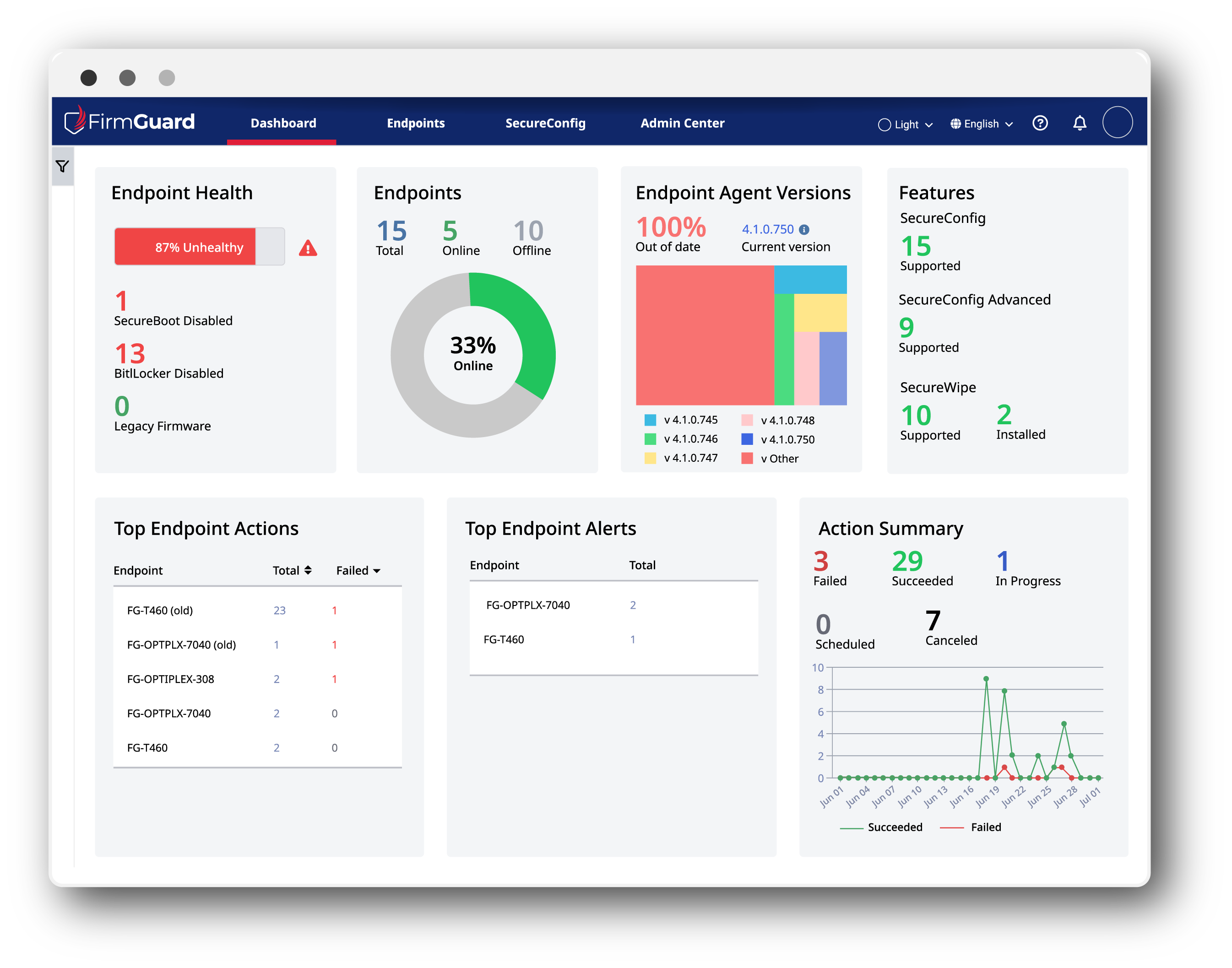Apple devices — iPhones, iPads, MacBooks — force firmware and OS updates to maintain stability and security. These updates aren’t just about adding new features; they’re about closing real-world vulnerabilities before they’re exploited. It’s an intentional move. Because when vulnerabilities reach the firmware layer, they become harder to detect, harder to remediate, and significantly more persistent.
So why is it that in the Windows ecosystem – where endpoint diversity and threat exposure are often much higher – firmware patching is largely overlooked?
Surface-Level Patching Isn’t Enough Anymore
Most MSPs would consider their patching strategy mature: OS updates are scheduled, third-party apps are managed, and compliance reports are delivered regularly. Dashboards show green. Alerts are quiet. But here’s the problem: most of these strategies stop at the operating system. They don’t account for the layer beneath – BIOS firmware.
Attackers have noticed this. And they’re adjusting their tactics. In fact, an official CISA publication notes “Adversaries have demonstrated that they already know how to exploit UEFI components for persistence, and they will only get better with practice.”
Firmware and BIOS-level vulnerabilities are increasingly being exploited because they offer what attackers want most: persistence, stealth, and control over the entire device. And once the firmware is compromised, it can bypass most of the tools MSPs rely on – including AV and EDR.
The BIOS Layer: Out of Sight, Still at Risk
The BIOS or UEFI firmware is the first code that runs when a machine starts. It initializes hardware, enforces early security settings like Secure Boot, and hands control off to the OS.
For attackers, compromising BIOS firmware is high value because:
- It runs below the OS and escapes most endpoint detection tools
- It can persist across disk wipes and reinstalls
- It provides privileged access before any endpoint controls are active
- It’s rarely updated
In fact, unless there’s a known hardware issue or the machine is part of a very mature IT environment, firmware vulnerabilities, such as Secure Boot being turned off or firmware being out of date, often go unaddressed.
Firmware Security: The Stats
Real-World Threats Below the OS
Recent firmware-level vulnerabilities have demonstrated how far threat actors are willing to go:
- PKFail: Leveraged improperly signed or untrusted UEFI platform keys to undermine Secure Boot, allowing unauthorized software to load during the boot process
- PixieFail: A cluster of vulnerabilities in the TianoCore EDK II network stack that enabled remote code execution, DoS attacks, DNS poisoning, and data leakage
- CosmicStrand, MoonBounce, LoJax: These malware families achieved persistent infection by embedding themselves in UEFI firmware, evading most detection methods.
These aren’t speculative vulnerabilities – they’ve been documented, and in some cases, used in active campaigns.
The BIOS firmware Visibility Gap
Most RMM platforms don’t expose firmware versioning or update status. AV tools don’t monitor the BIOS. Compliance checklists tend to assume firmware is the vendor’s responsibility, not the IT providers.
That leaves a blind spot – and attackers are leveraging it.
It’s also a missed opportunity to align more closely with compliance frameworks. For example, NIST 800-53 explicitly calls for integrity at all layers, including firmware. But without the tools to assess or manage it, MSPs often skip that step – not out of negligence, but because they don’t have practical access.
What the Future of Patch Management Looks Like
Patch management is no longer just about operating systems and apps. The evolving threat landscape makes BIOS firmware management a necessary part of endpoint security – especially in environments where compliance, data sensitivity, or uptime matters.
Here’s how we see the shift happening:
- Visibility: Knowing which firmware versions are in place, which devices are outdated, and where known vulnerabilities exist
- Control: The ability to schedule and apply updates across devices remotely, with minimal disruption to existing processes
- Standardization: Establishing baselines for firmware configurations and validating them as part of regular compliance efforts
This is already starting to happen in large enterprise IT environments. But for MSPs managing hundreds or thousands of distributed devices across clients, it’s been far more difficult to operationalize.
A More Practical Approach to BIOS Management
One of the key advancements is the ability to remotely interact with BIOS firmware – to monitor, update, configure, and even reimage it without needing onsite access. This approach allows MSPs to:
- Integrate BIOS management into their standard patching workflows
- Reduce risk from known firmware vulnerabilities
- Meet compliance requirements that previously required manual intervention
- Validate system integrity from the firmware up
It’s not about reinventing patch management. It’s about extending what you already do to a layer that’s historically been neglected.
Also, Compliance Implications
While many compliance standards don’t explicitly say “you must patch your BIOS” they do call for:
- System integrity at all layers
- Secure Boot enforcement
- Configuration monitoring
- Hardware root-of-trust
These aren’t achievable if firmware is left unmanaged. For organizations under NIST, CMMC, or ISO frameworks, firmware visibility is moving from best practice to expectation. As MSPs take on more regulated clients – think healthcare providers, legal firms, financial services – ignoring BIOS firmware could very soon become a compliance liability.
As a result, the role of an MSP is evolving from reactive problem-solver to proactive risk manager. And in that evolution, BIOS security can no longer be ignored.
Attackers are already targeting it. Vendors like Apple are already enforcing it. Regulators are already expecting it.
The question is whether the tools you’re using, and the processes you’ve built, are keeping up with where the threats are going.
Secure Your BIOS Firmware With FirmGuard
FirmGuard is the only remote BIOS security solution – allowing you to secure, configure, and update BIS firmware, as well as to reimage the endpoint at scale – with zero guesswork. You don’t need physical access.
With FirmGuard, You Can:
- See important BIOS security information – such as out of date or out of sync firmware, as well as endpoints in legacy boot mode or that have Secure Boot disabled
- Automatically apply vendor-specific updates at scale
- Reimage compromised endpoints to a known-good state – without touching the machine
So, whether you’re managing 50 endpoints, 5,000 or 50,000, we help you turn firmware into just another manageable layer of your patching strategy — no more blind spots, no more uncertainty. And MSPs that lead with firmware security aren’t just better protected — they’re winning more clients.







